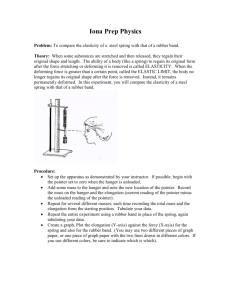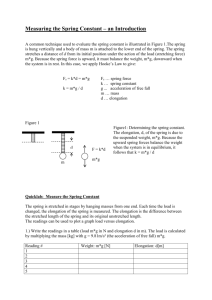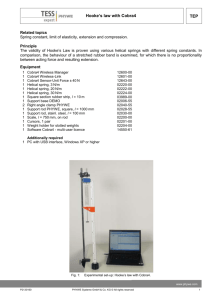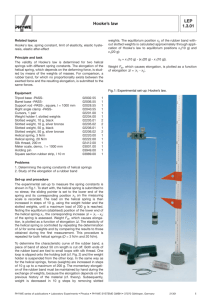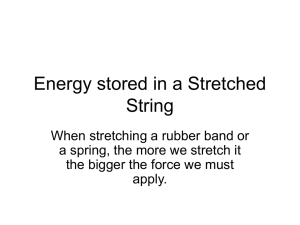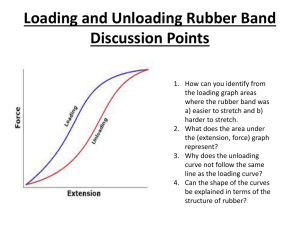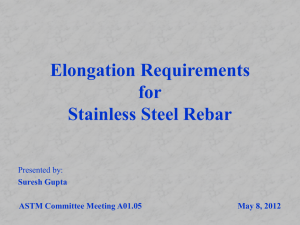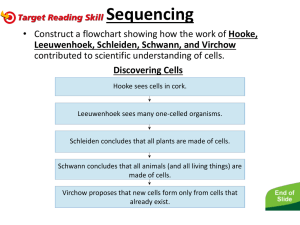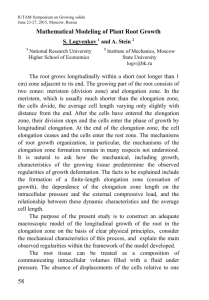Linear vs. Nonlinear
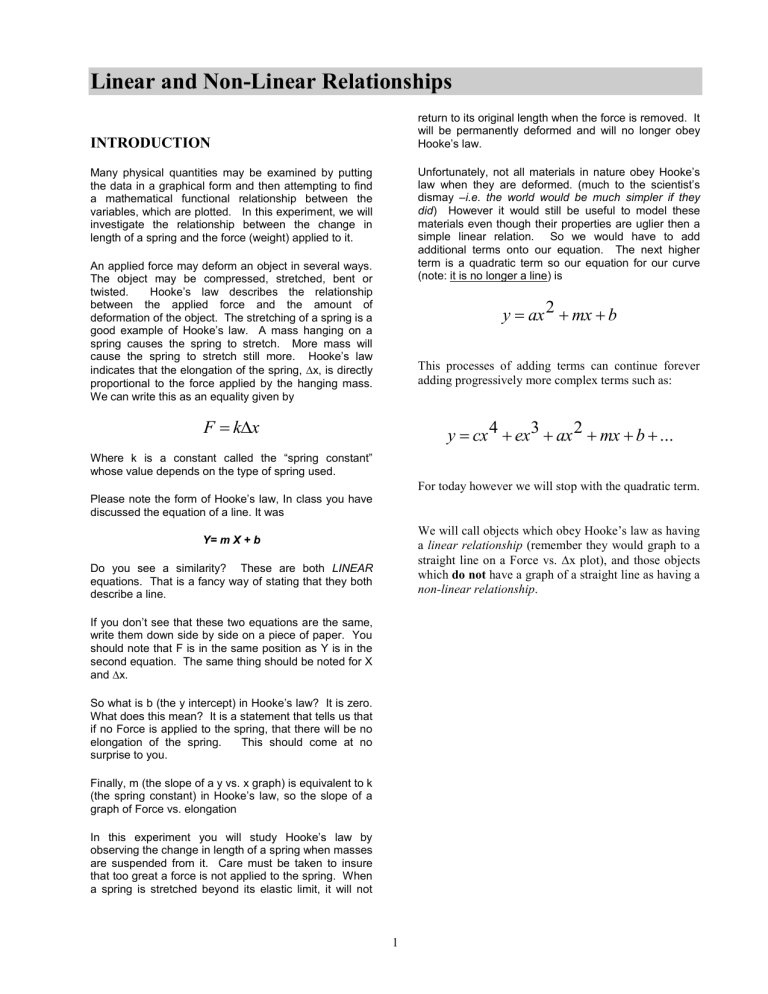
Linear and Non-Linear Relationships
INTRODUCTION
Many physical quantities may be examined by putting the data in a graphical form and then attempting to find a mathematical functional relationship between the variables, which are plotted. In this experiment, we will investigate the relationship between the change in length of a spring and the force (weight) applied to it.
An applied force may deform an object in several ways.
The object may be compressed, stretched, bent or twisted. Hooke’s law describes the relationship between the applied force and the amount of deformation of the object. The stretching of a spring is a good example of Hooke’s law. A mass hanging on a spring causes the spring to stretch. More mass will cause the spring to stretch st ill more. Hooke’s law indicates that the elongation of the spring,
x, is directly proportional to the force applied by the hanging mass.
We can write this as an equality given by
F
k
x
Where k is a constant called the “spring constant” whose value depends on the type of spring used.
Please note the form of Hooke’s law, In class you have discussed the equation of a line. It was
Y= m X + b
Do you see a similarity? These are both LINEAR equations. That is a fancy way of stating that they both describe a line.
If you don’t see that these two equations are the same, write them down side by side on a piece of paper. You should note that F is in the same position as Y is in the second equation. The same thing should be noted for X and
x.
So what is b (the y intercept) in Hooke’s law? It is zero.
What does this mean? It is a statement that tells us that if no Force is applied to the spring, that there will be no elongation of the spring. This should come at no surprise to you.
Finally, m (the slope of a y vs. x graph) is equivalent to k
(the spring constant) in Hooke’s law, so the slope of a graph of Force vs. elongation
In this experiment you will study Hooke’s law by observing the change in length of a spring when masses are suspended from it. Care must be taken to insure that too great a force is not applied to the spring. When a spring is stretched beyond its elastic limit, it will not return to its original length when the force is removed. It will be permanently deformed and will no longer obey
Hooke’s law.
Unfortunately, not all materials in nature obey Hooke’s law when they are deformed. (much to the scientist’s dismay –i.e. the world would be much simpler if they did ) However it would still be useful to model these materials even though their properties are uglier then a simple linear relation. So we would have to add additional terms onto our equation. The next higher term is a quadratic term so our equation for our curve
(note: it is no longer a line) is y
ax
2 mx
b
This processes of adding terms can continue forever adding progressively more complex terms such as: y
cx
4 ex
3 ax
2 mx
b
...
For today however we will stop with the quadratic term.
We will call objects which obey Hooke’s law as having a linear relationship (remember they would graph to a straight line on a Force vs.
x plot), and those objects which do not have a graph of a straight line as having a non-linear relationship .
1
PROCEDURE
1.
Suspend a spring and a weight pan from the short rod as shown in the illustration.
6.
Subtract the value of the position of the pan with no load from the position found in Step 4. The difference is the elongation of the spring. Record this elongation.
7.
Place additional masses in 50-gram increments on the pan and record the new positions. Calculate and record the force caused by the total mass on the pan. Also calculate and record the elongation of the spring.
8.
On a sheet of graph paper, plot a graph of force vs. elongation. This means on the x-axis you plot
X, and on the y-axis you plot the weight on the spring.
9.
Use your data and the CRICKET GRAPH to construct a graph of force vs. elongation. Select
Curve Fit/Simple from the main menu. The equation for a line is y = mx + b where m is the slope. (WHAT plotting program does OHS use)
10.
Repeat Steps 1 - 7 replacing the spring with a rubber band and using mass increments of 50 grams.
11. Plot your data for the rubber band as you did for the spring data. Note that if you try to fit the data with a line, the fit is very poor. Now use a quadratic fit. What do you observe?
2.
Place a meter stick along the long metal rod so that the end marked 0 cm is toward the ceiling. Use a rubber band to hold the meter stick in place as shown.
3.
Read the position of the bottom of the weight pan by looking at the markings on the meter stick. This is the reading with no load on the pan. Record this reading on the data sheet.
4.
Place a 150g mass on the pan and read and record the new position of the pan. Also record the mass and calculate the force it causes on the spring.
5.
Mass and Force are two separate concepts in
Physics. The force, which we are concerned with in this experiment, is the force of gravity acting on the added mass. This force is called weight (NOTE:
MASS AND WEIGHT ARE NOT THE SAME
QUANTITY) . In order to calculate the weight from the mass we will use Newton’s second law.
F
F
mass * g
mg
(Use g = 10 m/s 2 ; then the force of the spring
(weight) is m * g or m * 10 m/s 2 .)
2
DATA SHEET
300
350
400
450
500
0
150
200
250
Mass
(g)
Name: __________________________
Section: _________________________
Mass on spring
(kg)
0
Elastic Spring
Reading with no load __________ (cm)
Force on spring
(N)
0
Reading with load
(cm)
Elongation of spring
(cm)
0
QUESTIONS
1) What is the relationship between the elongation of the spring and the weight attached to the spring? How does your graph support or refute your answer?
2) What is the spring constant for your spring?
3) Looking at your graph for the spring, what do you predict to be the elongation of your spring when loaded with a weight of 0.2, 2.0, and 4.0 Newtons?
3
0
150
200
250
300
350
400
450
500
Experiment
9
DATA SHEET
Mass
(g)
Mass on spring
(kg)
0
Rubber Band
Reading with no load _________ (cm)
Force on spring
(N)
0
Reading with load
(cm)
Elongation of spring
(cm)
0
QUESTIONS:
1) Was the graph of elongation versus force for the rubber band a straight line? In other words, is the elongation of your rubber band proportional to the force exerted? If not, then it doesn’t follow Hooke’s law; state a reason why.
2) Can you find a “spring constant” for the rubber band? If not, why?
3) What would finally happen to the spring if you continue to add additional weights to the spring? What do we call this effect? And to the rubber band?
4
